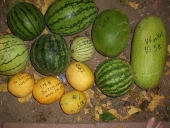Rachel Lindsay wrote:I have to hand-pollinate my limequat and my Meyer lemon in the winter when they come inside to live with us. They are both ever-bearing, and so we use the paintbrushes my daughter has in her paint sets to do the job. She always gets a kick out of being a real pollinator.
And we all three always love the incredible scent of citrus blossoms mixed with the scent of our Christmas tree, all in our living room!
Can you tell me how you take care of your citrus that you bring inside in winter? I'm in Texas and it gets too cold here to have citrus outside in the winter, which is new for me, since I spent the last 20 years in a tropical climate.
How big of a pot do you use, how do you maintain fertility in the pot, and do you use grow lights in the winter?
The idea of getting some citrus in the winter, or even just sweet-smelling blossoms, is very interesting to me, if it's not too involved! My kids would love that too. We grew lots of citrus at my old home, and the smell of the blossoms was just the best!










